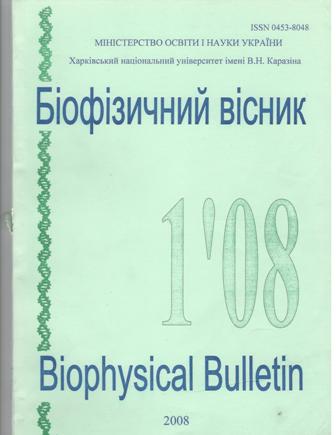Electrostatic contribution to the energy of complexation of aromatic antitumor antibiotics with DNA
Abstract
The study of electrostatic interactions during the complexation of actinomycin D, daunomycin, novatron, and nogalamycin with oligonucleotide duplexes containing from 4 to 16 base pairs was carried out. The analysis of the main components of electrostatic energy is carried out. The influence of the length of the DNA double helix on the energy of electrostatic interactions has been studied.It was shown that the calculation results for DNA duplexes with 8 and more base pairs are in good agreement with each other. A correlation was established between changes in the values of the angle of helical rotation and electrostatic interactions during intercalation unwinding of the insertion site, as well as a change in the electrostatic energy of interactions in the DNA duplex, similar for all antibiotics. In the same time intermolecular electrostatic interactions of neutral actinomycin D and novanthrone molecules with DNA oligomers differ significantly from those for DNA binding of positively charged daunomycin and nogalamycin. It has been shown that, in general, electrostatic interactions prevent the complexation of all four considered anti-tumor antibiotics with DNA.
Downloads
References
2. Neidle S., Waring M. J. Molecular aspects of Anti-cancer drug action. L.:Macmillan. - 1983. - 483 p.
3. Brana M.F. Cacho M., Gradillas A., Pascual-Teresa B., Ramos A. Intercalators as Anticancer Drugs// Curr. Pharm. Des. - 2001. - Vol.7. - p. 1745 - 1780.
4. Ren. J., Jenkins T.C. Chaires J. B. Energetics of DNA Intercalation Reactions // Biochemistry-2000.-Vol.39.-P. 8439-8447.
5. Haq I. Thermodynamics of drug-DNA interactions // Arch. Biochem. Biophys.-2002.-Vol.403-P. 1-15.
6. Honig В., Nicholls A. Classical Electrostatics in Biology and Chemistry // Science 1995. - Vol.268 - P. 1144-1149.
7. Sharp K.A. Electrostatic interactions in macromolecules // Curr. Opin. Struct. Biol. - 1994. - Vol.4. - P. 234-239.
8. Baginski M., Fogolari F., Briggs J.M. Electrostatic and Non-electrostatic Contributions to the Binding Free Energies of Anthracycline Antibiotics to DNA // J. Mol. Biol - 1997.-Vol.274.-P. 253-267.
9. Chaires J.B. Dissecting the free energy of drug binding to DNA // Anti-Cancer Drug Des.- 1996-Vol. 11 -P. 569-580.
10. Yang X.-L., Wang A.H.-J. Structural studies of atom-specific anticancer drugs acting on DNA // Pharm. Ther.-1999.-Vol.83.-P. 181-215.
11. Sharp K.A., Honig B. Calculating total electrostatic energies with the nonlinear Poisson-Boltzmann equation // J. Chem. Phys.-1990.-VoI.94.-P. 7684-7692.
12. Lee В., Richards F.M. The interpretation of protein structures: estimation of static accessibility // J. Mol. Biol.-1971.-Vol.55.-P. 379-400.
13. Rocchia W., Alexov E., Honig B. Extending the applicability of the nonlinear Poisson-Boltzmann equation: Multiple dielectric constants and multivalent ions // J. Phys. Chem. B.-2001.-Vol.105.-P. 6507-6514.
14. Berman H.M., Westbrook J., Feng Z., Gilliland G., Bhat T.N., Weissig H., Shindyalov I.N., Bourne P.E. The protein data bank // Nucleic Acids Res.-2000.-Vol.28.-P. 235-242.
15. Brunger A.T. X-PLOR. A system for X-ray crystallography and NMR-Yale: Univ. Press, 1992.-382 p.
16. Cornell W.D., Cieplak P.,. Bayly C.I, Gould I.R., Merz K.M.J., Ferguson D.M., Spellmeyer D.C., Fox Т., Caldwell J.W., Kollman P.A. A second generation force field for the simulation of proteins, nucleic acids, and organic molecules // J. Am. Chem. Soc. 1995.-Vol.117.-P. 5179-5197.
17. Cieplak P., Rao S.N., Grootenhuis P.D.J., Kollman P.A. Free energy calculations on base specificity of drug-DNA interactions: Application to daunomycin and acridine intercalation into DNA // Biopolymers-1990.-Vol.29.-P. 717-727.
18. Allison S.A. End effects in electrostatic potentials of cylinders: models for DNA fragments // J. Phys. Chem.-1994.-V. 98.-P. 12091-12096.
19. Neidle S., Pearl L.H., Herzyk P., Berman H.M. A molecular model for proflavine-DNA intercalation // Nucleic Acids Res.-1988.-Vol.16.-P. 8999-9016.
20. Kotovych G., Lown J.W., Tong J.P. High-field 1H and 31P NMR studies on the binding of the anticancer agent mitoxantrone to d(CpGpApTpCpG)2 // J. Biomol. Struct. Dyn.- 1986.-Vol.4.-P. 111-125.
21. Frederick C.A., Williams L.D., Ughetto G., van der Marel G.A., van Boom J.H., Rich A., Wang A.H. Structural comparison of anticancer drug-DNA complexes: adriamycin and daunomycin // Biochemistry-1990.-Vol.29.-P. 2538-2549.
22. Snyder J.G., Hartman N.G., D'Estantoit B.L., Kennard O., Remeta D.P., Breslauer K.J. Binding of actino-mycin D to DNA: Evidence for a nonclassical high-affinity binding mode that does not require GpC sites // Proc. Natl. Acad. Sci. USA.-1989.-Vol.86.-P. 3968-3972.
23. Feigon J., Denny W.A., Leupin W., Kearns D.R. Interactions of antitumor drugs with natural DNA: 'H NMR study of binding mode and kinetics // J. Med. Chem.-1984.-Vol.27.-P. 450-465.
24. Waring M. Variation of the supercoils in closed circular DNA by binding of antibiotics and drugs: evidence for molecular models involving intercalation // J. Mol. Biol.-1970.-Vol.54.-P. 247-279.
25. Kapuscinski J., Darzynkiewicz Z., Traganos F., Melamed M.R. Interactions of a new antitumor agent, 1,4-dihydroxy-5,8-bis[[2-[(2-hydroxyethyl)amino]-ethyl]amino]-9,10-anthracenedione, with nucleic acids // Biochem. Pharm.-1981.-Vol.30.-P. 231-240.
26. Medhi С, Mitchell J.B.O., Price S.L., Tabor A.B. Electrostatic Factors in DNA Intercalation // Biopolymers.-1999.-Vol.52.-P. 84-93.
27. Rudnicki W.R., Kurzepa M., Szczepanik Т., Priebe W., Lesyng B.A. Simple model for predicting the free energy of binding between anthracycline antibiotics and DNA // Acta Biochim. Polon.-2000.-Vol.47.-P. 1 -9.
Authors who publish with this journal agree to the following terms:
- Authors retain copyright and grant the journal right of first publication with the work simultaneously licensed under a Creative Commons Attribution License that allows others to share the work with an acknowledgement of the work's authorship and initial publication in this journal.
- Authors are able to enter into separate, additional contractual arrangements for the non-exclusive distribution of the journal's published version of the work (e.g., post it to an institutional repository or publish it in a book), with an acknowledgement of its initial publication in this journal.
- Authors are permitted and encouraged to post their work online (e.g., in institutional repositories or on their website) prior to and during the submission process, as it can lead to productive exchanges, as well as earlier and greater citation of published work (See The Effect of Open Access).





